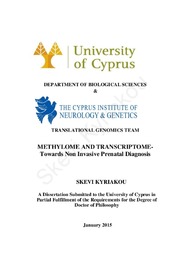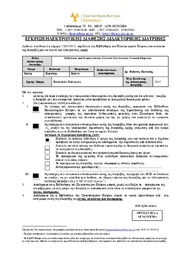| dc.contributor.advisor | Patsalis, Philippos | en |
| dc.contributor.author | Kyriakou, Skevi K. | en |
| dc.coverage.spatial | Cyprus | en |
| dc.creator | Kyriakou, Skevi K. | en |
| dc.date.accessioned | 2015-07-22T05:46:10Z | |
| dc.date.accessioned | 2017-08-03T09:25:02Z | |
| dc.date.available | 2015-07-22T05:46:10Z | |
| dc.date.available | 2017-08-03T09:25:02Z | |
| dc.date.issued | 2015-05 | |
| dc.date.submitted | 2015-05-25 | |
| dc.identifier.uri | https://gnosis.library.ucy.ac.cy/handle/7/39104 | en |
| dc.description | Includes bibliographical references (p. 67-76). | en |
| dc.description | Number of sources in the bibliography: 121 | en |
| dc.description | Thesis (Ph. D.) -- University of Cyprus, Faculty of Pure and Applied Sciences, Department of Biological Sciences, 2015. | en |
| dc.description | The University of Cyprus Library holds the printed form of the thesis. | en |
| dc.description.abstract | Η μη-επεμβατική προγεννητική διάγνωση αποτέλεσε ένα από τους πιο απαιτητικούς ερευνητικούς τομείς των δύο τελευταίων δεκαετιών. Η ανακάλυψη της παρουσίας ελεύθερου εμβρυϊκού DNA στην μητρική κυκλοφορία αποτέλεσε κινητήριο μοχλό για πολλές ομάδες που στόχευαν στην ανίχνευση εμβρυοειδικών βιοδεικτών. Η ανίχνευση του εμβρυϊκού DNA (~10%) παρουσία μητρικού DNA (90%) απαιτεί την εφαρμογή μεθόδων εμπλουτισμού υψηλής ευαισθησίας και ακρίβειας.
Μέσω της επιγενετικής, η ομάδα μας ταυτοποίησε διαφορετικά μεθυλιωμένες περιοχές (DMRs) του εμβρύου και της μητέρας στα χρωμοσώματα 21, 18, 13, X και Y, και ανέπτυξε μια μη επεμβατική προγεννητική μέθοδο για την ανίχνευση της τρισωμίας 21.
Ο πρωταρχικός σκοπός της μελέτης αυτής αφορά στη διερεύνηση της πιθανότητας η μεταβλητότητα του εμβρυϊκού ποσοστού να επηρεάσει το σωστό προσδιορισμό της τρισωμίας 21, χρησιμοποιώντας την υπάρχουσα μέθοδο MeDIP. Με τη χρήση qPCR, πραγματοποιήθηκε ποσοτικοποίηση 224 μητρικών δειγμάτων αίματος και 124 μητρικών δειγμάτων πλάσματος, για την συσχέτιση των εμβρυϊκών ποσοστών και της διαγνωστικής αξίας της μεθοδολογίας. Τα αποτελέσματα έδειξαν ότι η μεταβλητότητα των εμβρυϊκών ποσοστών δεν επηρεάζει τον σωστό καθορισμό της τρισωμίας 21.
Ο δεύτερος στόχος αποσκοπεί στην ανάπτυξη μιας μεθόδου εμβρυϊκού εμπλουτισμού, για την αύξηση του ποσοστού του εμβρυϊκού DNA που βρίσκεται στη μητρική κυκλοφορία κατά τη διάρκεια της εγκυμοσύνης και το σωστό προσδιορισμό των εμβρύων με τρισωμία 21. Χρησιμοποιώντας δείγματα χοριονικών λαχνών (CVS) και δείγματα πλάσματος από μη εγκυμονούσες γυναίκες, ετοιμάστηκαν δείγματα που μιμούνται τα ποσοστά DNA (μητρικό και εμβρυϊκό) όπως εντοπίζονται στο πλάσμα της μητέρας κατά την κύηση. Τα συγκεκριμένα δείγματα, χρησιμοποιήθηκαν για ανοσοκατακρήμνιση ακολουθούμενη από digital PCR, επιτυγχάνοντας τη σωστή ταξινόμηση των τρισωμικών δειγμάτων από τα φυσιολογικά, και καθιστώντας τη νέα μέθοδο έτοιμη για επικύρωση. Ο τρίτος σκοπός αυτής της μελέτης, αφορά στην επέκταση του πίνακα των εμβρυϊκών βιοδεικτών μελετώντας το εμβρυϊκό RNA. Αυτό θα προσδιορίσει, διαφορικά εκφραζόμενα γονίδια (DEGs) μεταξύ των φυσιολογικών εμβρύων και των εμβρύων με τρισωμία 21. Μικροσυστοιχίες έκφρασης που καλύπτουν όλο το RNA, εφαρμόστηκαν σε RNA δείγματα από φυσιολογικές και τρισωμικές χοριονικές λάχνες (CVS), και συγκρίθηκαν με τα αντίστοιχα RNA δείγματα από τη μητέρα. Πραγματοποιήθηκαν μελέτες συσχέτισης, των DEGs σε μεταγραφικό επίπεδο σε σχέση με το πρότυπο μεθυλίωσης και τον φαινότυπο του συνδρόμου Down. Ανιχνεύθηκαν πολλαπλά DEGs ειδικά για την τρισωμία 21, πολλά από τα οποία βρέθηκαν να σχετίζονται με το φαινότυπο του συνδρόμου Down. Τα μεθυλιωμένα πρότυπα των DEGs δεν έδειξαν να συσχετίζονται με το μεταγραφικό επίπεδο. Λόγω της μεταβλητότητας του μεταγραφικού επιπέδου που παρουσιάζεται μεταξύ διαφορετικών ατόμων, απαιτείται περαιτέρω διερεύνηση σε μεγαλύτερο αριθμό δειγμάτων προκειμένου να επικυρωθούν τα ευρήματα αυτής της μελέτης.
Συμπερασματικά η μελέτη αυτή χρησιμοποιεί υπάρχουσες διαφορές μεταξύ της μητέρας και του εμβρύου, και πέτυχε την ανάπτυξη μιας μη επεμβατικής προγεννητικής μεθοδολογίας για τη διάκριση της τρισωμίας 21 από φυσιολογικά έμβρυα. Επιπλέον, επέκτεινε τον πίνακα των εμβρυϊκών βιοδεικτών με τον εντοπισμό νέων διαφορών ανάμεσα στη μητέρα και το έμβρυο που θα μπορούσαν στο μέλλον να χρησιμοποιηθούν για την μη επεμβατική προγεννητική διάγνωση. | el |
| dc.description.abstract | Non-invasive prenatal diagnosis has been one of the most challenging fields in the past two decades. The discovery of fetal nucleic acids in the maternal circulation encouraged several groups to work on the identification of fetal specific biomarkers. Recovery of fetal DNA fragments (~10%) in the presence of maternal DNA (90%) requires high sensitivity and specificity enrichment methods. Our group has successfully used epigenetics to identify differentially methylated regions (DMRs) between the fetus and the mother on chromosomes 21, 18, 13, X and Y, and developed a non-invasive prenatal methodology (MeDIP-qPCR) for the detection of trisomy 21.
The first objective of this study aims to investigate whether the variability of fetal percentage among individuals affects the correct classification of trisomy 21 using the existing MeDIP methodology. Quantification of 224 maternal whole blood and 124 maternal plasma samples was carried out, by qPCR, followed by correlation studies between the fetal percentages and the diagnostic value of the methodology. Results showed that the variability of fetal amount among individuals does not interfere with the correct classification of trisomy 21.
The second objective targets the development of a robust fetal epigenetic enrichment method which will increase the proportion of fetal DNA in maternal circulation during pregnancy and correctly classify trisomy 21 fetuses. Spike-in samples were prepared using chorionic villi samplings (CVS) DNA and non-pregnant female plasma DNA which are used to imitate the maternal DNA. These samples underwent immunoprecipitation followed by digital PCR for quantification. Correct classification of trisomy 21 spike-in samples from normal ones was achieved. This newly developed method is now ready for validation.
The third objective of this study aims to expand the panel of fetal specific biomarkers by uncovering the fetal transcriptome. This will identify differentially expressed genes (DEGs) among the trisomy 21 and normal fetuses from their mothers. Expression microarrays covering the whole transcriptome were applied to normal and trisomy 21 CVS RNA samples together with their matching maternal RNA. Association studies of identified DEGs transcription level with their methylation patterns and Down syndrome phenotype were performed. Multiple trisomy 21 specific DEGs were identified and were found to be associated with the Down syndrome phenotype. Methylation patterns of DEGs showed no association with the transcription level. Due to the transcription level variability among individuals, identified DEGs must be further investigated in a large-scale study in order to confirm our findings.
As a conclusion this work utilised already existing differences between the mother and the fetus, DMRs, and succeeded the development of a non-invasive prenatal methodology for the discrimination of trisomy 21 from normal fetuses. In addition, it expanded the panel of fetal specific biomarkers by identifying new differences between the mother and the fetus which can potentially be used for non-invasive prenatal diagnosis. | en |
| dc.format.extent | xiv, 103, [6] p. : col. ill., diagrs., tables ; 31 cm. | en |
| dc.language.iso | eng | en |
| dc.publisher | Πανεπιστήμιο Κύπρου, Σχολή Θετικών και Εφαρμοσμένων Επιστημών / University of Cyprus, Faculty of Pure and Applied Sciences | |
| dc.rights | info:eu-repo/semantics/openAccess | en |
| dc.rights | Open Access | en |
| dc.subject.lcsh | Prenatal diagnosis | en |
| dc.subject.lcsh | Diagnosis, Noninvasive | en |
| dc.subject.lcsh | Methylation | en |
| dc.subject.lcsh | Transcription | en |
| dc.title | Methylome and transcriptome - towards non invasive prenatal diagnosis | en |
| dc.title.alternative | Μεθυλίωση και μεταγραφή- προς μη επεμβατική προγεννητική διάγνωση | el |
| dc.type | info:eu-repo/semantics/doctoralThesis | en |
| dc.contributor.committeemember | Πιτσουλή, Χρυσούλα | el |
| dc.contributor.committeemember | Χριστοδούλου, Κυπρούλα | el |
| dc.contributor.committeemember | Λάμνησου, Κλεονίκη | el |
| dc.contributor.committeemember | Φελέκκης, Κυριάκος | el |
| dc.contributor.committeemember | Pitsouli, Chrysoula | en |
| dc.contributor.committeemember | Christodoulou, Kyproula | en |
| dc.contributor.committeemember | Lamnissou, Kleoniki | en |
| dc.contributor.committeemember | Felekkis, Kyriakos | en |
| dc.contributor.department | Τμήμα Βιολογικών Επιστημών / Department of Biological Sciences | |
| dc.subject.uncontrolledterm | ΜΗ-ΕΠΕΜΒΑΤΙΚΗ | el |
| dc.subject.uncontrolledterm | ΕΜΒΡΥΙΚΟ | el |
| dc.subject.uncontrolledterm | ΜΕΘΥΛΙΩΣΗ | el |
| dc.subject.uncontrolledterm | ΜΕΤΑΓΡΑΦΗ | el |
| dc.subject.uncontrolledterm | NON-INVASIVE | en |
| dc.subject.uncontrolledterm | EMNBRYONIC | en |
| dc.subject.uncontrolledterm | METHYLATION | en |
| dc.subject.uncontrolledterm | TRANSCRIPTION | en |
| dc.identifier.lc | RC71.6.K87 2015 | en |
| dc.author.faculty | Σχολή Θετικών και Εφαρμοσμένων Επιστημών / Faculty of Pure and Applied Sciences | |
| dc.author.department | Τμήμα Βιολογικών Επιστημών / Department of Biological Sciences | |
| dc.type.uhtype | Doctoral Thesis | en |
| dc.rights.embargodate | 2015-11-25 | |


